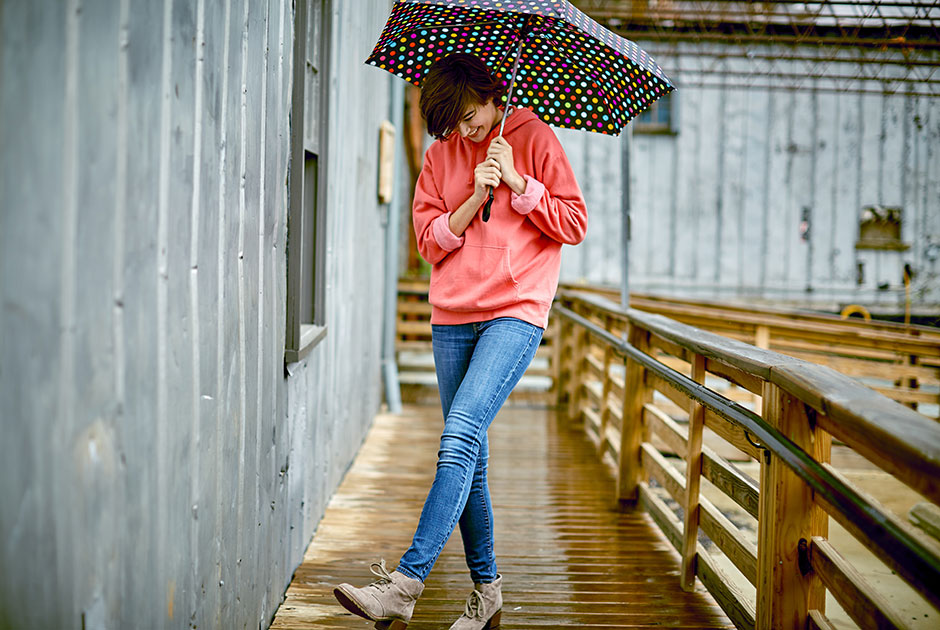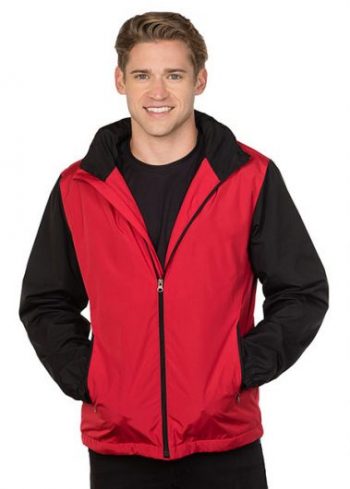September 20, 2018
The outerwear category steadily has been climbing the apparel-industry ladder in recent years. Evolving from being highly functional but not fashionable, to a period of being highly fashionable but lacking any real purpose, today’s jackets and outerwear now have become essential statement pieces, where functionality successfully meets fashion.
“Jackets, in many cases, are the finishing piece [for a wardrobe or outfit],” says Jeanene Edwards, vice president of activewear marketing and merchandising, Fruit of the Loom and JERZEES. “It’s the last thing you put on, and first thing other people see. Given the frequency of wear, consumers tend to be a bit more considerate when purchasing a jacket because it’s going to be used more, it needs to be stylish, yet it needs to be functional, warm and comfortable.”
Marcus Davis, product development manager of HanesBrands agrees, saying that cross functionality is key. Outerwear must transition from one part of the day into the next.
“With the convergence of active and lifestyle apparel — where everything meets in the middle these days — consumers want versatile pieces that go with them throughout their day,” he says. “So we’re seeing apparel that serves a purpose in keeping us warm, keeping us comfortable, as well as looking good in the sense that it’s something that can be worn to the workplace, to the gym or out with family and friends.”
Lightweight, stylish, yet practical alternatives have left heavyweight options in the dust.
Style & Multi-Function Design
With outerwear’s changing role in end users’ wardrobes, suppliers are kept on their toes, transforming what could be considered a challenge into an innovative outreach.
“I don’t see that as a challenge in the sense that it’s difficult to stay on top of the current trends to be relevant,” says John Perez, marketing manager of Tri-Mountain. “Yes, of course we must do that, but instead, I see it as a challenge in that it encourages innovation in all that we do in terms of fashion and features. We’re making apparel that rivals the looks of retail fashion and we’re using technology, fabrics and features in apparel that [are] also found in leading brands.”
Materials make the functional difference in lightweight jackets. Although everyone has a simple, lightweight jacket in core colors, Perez says the difference to the end user will come in a fashionable and functional design, such as Tri-Mountain’s style J1480 offered in neutral core colors (black, gray and navy), as well as bright red and brilliant blue.
“What we’ve done is create companion, lightweight jackets that are windproof and water resistant, with a light-fleece liner, concealed hood and color-block design,” he says.
The lightweight feature is evident when considering other brands. According to Andrea Cancellieri, president and owner of GAME Sportswear, jackets previously had a choice of two types of linings: quilt or Kasha. Now, they mainly are lined with taffeta or mesh, allowing a lighter weight while continuing to be breathable and retain warmth simultaneously.
She also says this concept applies to outer-shell materials. “Presently, with so many different polyesters on the market, they are softer, lighter and much quieter,” she says. “Several of our styles now have gussets for added comfort.”
Ken White, Cotton Heritage’s vice president of sales, has noticed the company’s French terry offerings becoming more popular for men and women. The 7.5-ounce fabric lends itself to layering, a universal theme found in outerwear options. For example, Cotton Heritage’s French terry full-zip hoodie is an accessible piece to have in one’s closet. It is lightweight and easy to carry throughout the day for evening wear during cooler seasons.
Stretch is another common feature trending with lightweight outerwear, notably woven jackets. Edwards says this characteristic allows for a slightly closer, perhaps more tailored fit, yet it’s still comfortable for movement throughout the day.
Wicking, quick-dry, abrasion-resistant and thermo-regulating fabrics also are features incorporated into outerwear design, along with more utilitarian features such as exterior pockets with zippers that have inside hidden pockets, providing an extra layer of security for travelers and commuters.
The Future of Outerwear
Although outerwear finally has found the middle ground between fashion and function, high-tech elements are beginning to dominate.
“Wearable tech in jackets is not only on the horizon, it’s already here,” Edwards says. “Tommy Hilfiger designed jackets that had solar-powered panels so you could recharge your phone. Levi’s worked with Google on a trucker jacket that incorporates conductive yarn into the left cuff, so it acts like a screen. And, of course, high visibilty that uses fiber-optic lighting is being worked on by numerous brands.”
A new wave of wearable technology continues to steer the outerwear category toward the future, and HanesBrands’ Davis says the apparel industry can benefit without negatively impacting the environment.
“Across Alternative Apparel, Hanes and Champion, we are constantly looking for ways to reduce our carbon footprint,” he says. “For our new ComfortWash garment-dyed apparel, the cotton used to create our jersey and fleece fabrics has been sourced from American farms. By developing apparel that performs inherently, we’ll reduce the overall impact. Our EcoSmart products, for example, keep more than 70 million plastic bottles from landfills each year.”
Fashion Roundtable
Impressions asked a few suppliers which fabrics continue to be the most popular with today’s outerwear. Following is what they had to say:
Andrea Cancellieri, GAME Sportswear: Almost entirely polyester of one sort or another is still popular. Polyester can be made to look like corduroy, oxford, satin, rip-stop and even pinstriped.
Marcus Davis, HanesBrands: Fleece and French terry continue to be popular. French terry, once seen predominantly in womenswear, is more acceptable now as an all-day layering piece for both genders and all ages. Fleece zip-up hoodies are now seen as all-day, everyday choices. Eco-friendly fabrics are very important. Customers want apparel that is low-impact.
Jeanene Edwards, Fruit of the Loom/JERZEES: Warmth without weight or bulk is a big trend right now, incorporating fabric linings like Thinsulate and Ultralight Down. Finishes that provide water-proof and wind-proof [properties] are also big, especially when it makes the jacket breathe so you stay dry and comfortable.
John Perez, Tri-Mountain: Our new Layer Knit styles have been very popular this past year. The material reminds a lot of people of a wetsuit or of neoprene. It has a soft, spongy feel. The material is very comfortable, it’s meant to conform to the body and is very much an athleisure style.
Ken White, Cotton Heritage: Our new three-end fleece is turning out to be more popular. It gives the garment a great hand, it’s cotton faced, offers superior printability and has great stretch for improved comfort.
More Build Your Business
March 29, 2024
If you’re a print shop owner who’s curious about the benefits of sustainable practices, now is a great time to start on the path toward a greener, cleaner and more profitable future for your decorated-apparel business.
FULL STORY
March 26, 2024
Team sports took a back seat during the pandemic, and as expected, the athletic and teamwear decorated-apparel market saw a major downturn in the Covid years. Since then, though, the industry has begun to right itself.
FULL STORY
March 25, 2024
As part of his “Ask the Experts” series, Impressions Content Director, Adam Cort, discusses the state of direct-to-film (DTF) technology with “Ninja Mike,” founder and CEO of custom heat-transfer specialist Ninja Transfers.
FULL STORY





